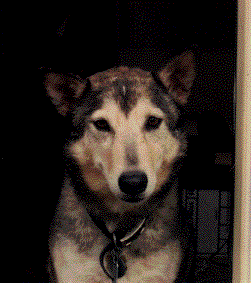

| Kira was a husky/shepherd mix, about four years old when she joined our family on December 18, 1991. Her previous owners surrendered her to the animal shelter when they moved out of town. Because she had been a strictly outdoor dog and wasn't housebroken, the shelter didn't consider her a good adoption prospect, but my daughter Hannah, who was working at the shelter, saw her potential and asked to take her home over Christmas to see if she could be trained. In fact, she was so used to being outside that it never occurred to her to do anything in the house, and our only problem was that she was frightened of slippery floors and didn't understand stairs. Although she never quite got over the fear of linoleum, she adjusted rapidly to indoor life, and was an exemplary household member. Kira's story is an object lesson in shelter adoptions. We never would have found out how wonderful she was if Hannah hadn't taken that chance. There are probably many great dogs euthanized that might well be better pets than the puppies adopted and sometimes returned. They're worth considering. Kira loved to play ball, to go on hikes, and to ride in the car, and from the very first, she always came when she was called. She also sang opera: I was doing genealogy on my computer one Saturday afternoon, listening to the Metropolitan Opera broadcast of Carmen, when Kira started singing along, surprisingly well in tune. Her other favorite music included a CD of Puccini arias, appropriately a Kiri Te Kanawa recording, and some Joan Baez songs. Kira had strong maternal instincts, and always stepped in to "mother" all manner of baby animals that we've taken in over the years. She also took on the role of "hall monitor dog", which involved ratting on her fellow four-leggeds. We always knew we needed to get up and look around when we heard her barking, because somebody was in the trash. When another dog was being chastised for a misdeed, Kira would second the motion by barking ferociously. Hannah saved Kira's life again, when she had complications of a long-standing heartworm infection that was not detected in her initial screening at the shelter. This was nearly fatal, but Hannah pulled her through with constant, loving care. In the summer of 1997 she developed osteosarcoma. She survived amputation of her left hind leg and subsequent chemotherapy, learning to walk remarkably well on three legs and even going trick-or-treating that Halloween, but the long-term prognosis was poor, and in spring 1998 the cancer returned in her lungs. She died peacefully at Hannah's house on the evening of May 22, 1998. We still miss her.
|